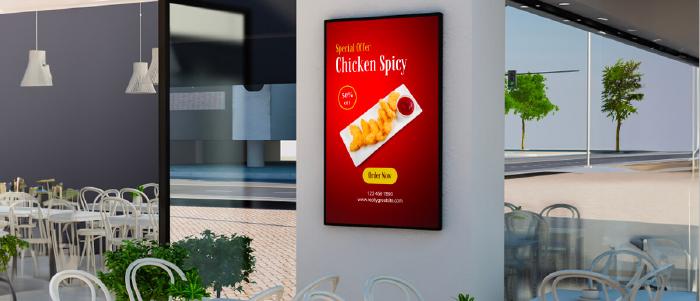
Dec 4 2024
7 min read

17 trees, 264 kilograms of air pollution and 26,281 litres of water.
That’s what it costs to produce one ton of paper.
Is the trade-off worth it? Maybe a few decades ago, yes. But considering the climate crisis we’re in today, businesses need to consider replacing their traditional paper signage with something more eco-friendly.
Can digital signage be a sustainable alternative to your billboards, store signs and menus? Read on to find out.
In a nutshell: yes, digital signage is eco-friendly. Paper accounts for around 26% of total waste at landfills, proving how traditional signage can be a major contributor to pollution.
That’s where digital signage comes in. Here are five reasons why sustainable signage is a good option for your business:
Most modern digital displays are designed to consume minimum power. When possible, choose an LED display — they consume around 40% less energy than other displays and help reduce CO2 emissions.
Many LED displays come with automatic brightness adjustment based on the ambient light in the room. This helps you easily maximize energy usage, resulting in reduced operating costs and a lighter environmental footprint.
Samsung is one brand that’s recognized the impact digital displays have on sustainability goals. The brand donated several TVs and digital signage to Green Pea — an eco-friendly shopping mall in Italy — to promote a more sustainable future.

You’ve launched a new marketing campaign with eye-catching posters and flyers plastered everywhere. But then, a sale or special offer comes up. Updating your traditional signage means:
You’ll need to create entirely new posters and flyers with the updated message.
This means tossing out the perfectly good old ones, often ending up in landfills.
This cycle repeats for every new promotion or update, generating a lot of waste.
With sustainable signage, updating your content is as easy as a few clicks of a button. This lets you keep your messaging current and relevant, without the wastage. Not only does it save time, but it also minimizes the environmental impact associated with constant printing and disposal of outdated materials. Humongous screens like jumbotrons also enable real-time updates, ensuring instant content changes without delays.
Traditional signage is prone to wear and tear. Posters, signs and flyers fade and deteriorate when exposed to weather and sunlight, requiring frequent replacements. This generates a significant amount of waste.
Built to withstand daily use, digital displays are more durable than traditional signage. Most outdoor LED digital signage displays — operating at full power every hour of the day — last an average of 100,000 hours. This translates to about 10 years of operation!
This means fewer replacements and less waste, contributing to a more sustainable signage solution. Plus, with minimal maintenance requirements, you’ll save both time and resources in the long run.
One of the biggest challenges with traditional signage is that you have to physically travel to every location if you need to update it. But with digital signage, updates can be made remotely, from the comfort of your office.
Try For FreeNo more driving around to update physical signs. This translates to fewer vehicles on the road, leading to lower carbon emissions and cleaner air. Remote updates also save valuable time and resources, allowing businesses to focus on other crucial aspects of their operations.
There’s no need for screens to be on 24/7. Businesses can schedule content to run during business hours and automatically power down displays at night. This reduces energy consumption, leading to -
By using less electricity, digital signage contributes to a smaller carbon footprint.
Reduced energy consumption translates to lower electricity bills, putting more money back into your business.
Here’s a video of how you can schedule content on Pickcel’s software to help you understand how the feature works:
Even digital signs eventually reach the end of their lifespan. However, unlike traditional signage that often ends up in landfills, digital displays offer a sustainable alternative.
Many digital signs are constructed from acrylic and polycarbonate, materials that can be chemically recycled. This process breaks them down into their original components in a safe and environmentally friendly way.
The recycled components can then be used to create entirely new products, like furniture, coasters, or even pipes. This extends the lifespan of the materials and reduces the need for virgin resources.
We all know sustainability is crucial for the planet’s future. But beyond the moral obligation, there’s a strong business case for it. Studies suggest industries can save a staggering $437 billion annually by 2030 through improved energy efficiency, and sustainable signage can be a huge part of that. Here’s how you can use it to improve your bottom line:
Lower energy consumption translates to reduced electricity bills. Additionally, eliminating printing and disposal costs of traditional signage leads to long-term savings.
Consumers are increasingly drawn to brands that prioritize sustainability. By embracing eco-friendly signage, you project a positive image and attract environmentally conscious customers.
Digital signage software allows for remote updates, saving time and resources compared to managing physical signs across locations.
While the upfront cost of sustainable signage might be higher, the long-term savings in energy, printing, and waste disposal often make it a worthwhile investment.
Traditional signage leaves a big footprint – paper waste, constant reprints, and energy-intensive production. As a business, going digital is your next logical step — considering the potential for long-term savings and a more positive brand image.
If you’re thinking about implementing sustainable signage, our team at Pickcel can help you find the perfect solution for your business. Contact us today to see how digital signage can work for you!

Dec 4 2024
7 min read

Nov 20 2024
8 min read

Nov 8 2024
6 min read

Oct 18 2024
9 min read
Take complete control of what you show on your digital signage & how you show it.
Start Free Trial Schedule My DemoSee How to Boost Sales & Branding with Digital Signage -40% Less Work, Faster Updates, Better Visibility
Unlock Exclusive Insights